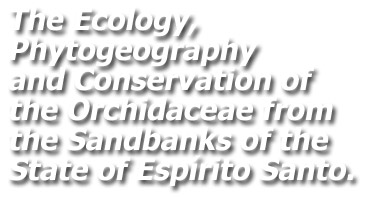
![]()
 |
|
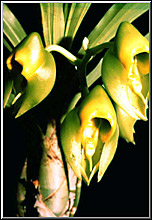 |
ON:
In your opinion, what is the explanation of the presence of typical plants
of the Amazon region in the State of Espírito Santo? What would be the phytogeographical explanation? Catasetum macrocarpum, for example, is very interesting because it had been reported to norht and norheast of the country. In Espírito Santo, it is a new occurrence. Cláudio: In Espírito Santo? It is new. There are many new occurrences for Espírito Santo. Because after Ruschi, I came. He stayed much more in the Atlantic Forest and I went to the sandbank. This plant occurs in the south of Bahia, I collected Catasetum macrocarpum in Trancoso. Bahia is northeast, in fact, and Espírito Santo is southeast, but this forest of the south of Bahia comes until the Doce River (Rio Doce, in the state of Espírito Santo), more or less, so, it would be the Hylean baiana also occurring in Espírito Santo. |
|
ON: So this occurrence happens in the boundary with the state of Bahia? Cláudio: This frontier is badly done. |
| ON:
You also verified the occurrence of Habenaria fastor, which is new
occurrence to Espírito Santo.
Cláudio:
No. Habenaria fastor is not a new occurrence. There is a mistake
in Pabst's book that has not been noticing by many people. We should pay
attention to some things that I think it is worth to talk about. |
|
|
ON: So it would be former reported to Espírito Santo under the name of Habenaria nabucoi? Cláudio:
Yes, it has been reported with another name. It occurred with another
species but can't remember all of them now. However there will be many
new citations to the state Espírito Santo. Why? Because the sandbank
of Espírito Santo has, inside it, this two kind of different forests,
it means, when the Tableland forest finishes, starts the hillside Atlantic
forest. This sandbank has suffered the influence of all those things. ON: Do you consider your inventory about the sandbank exhaustive? Cláudio:
Yes, I do. ON: Cattleya forbesi... Cláudio: or... ON: Cattleya intermedia? Cláudio: We don't know. ON: Cattleya intermedia has never been found in Espírito Santo, at least until now. Cláudio:
Never, but this work was the first step to those things. ON: Of course. |
| Cláudio: This is a big area because in a sandbank, there are those two sandy cords, the external (next to the sea) and the internal, between them, the swampy area which is the biggest part. However to collect all those species of Habenaria, I don't need to walk all through the swamp because it is uniform. If I study just a part of this, I can collect all species of Habenaria. By the way, Habenaria fastor, for example, is a plant from swamp. |
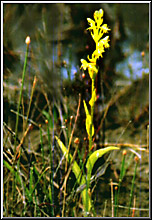 Habenaria repens |
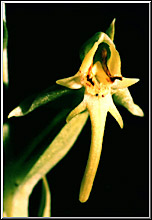 Habenaria leptoceras |
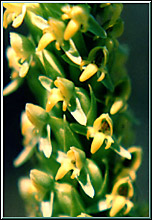 Habenaria parviflora |
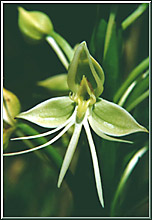 Habenaria fastor |
|
ON: Did you find Bletia catenulata in the sandbanks of Espírito Santo? Cláudio: I've never found it there. It occurs until Bahia... ON: It also occurs in state of Rio de Janeiro. There also is in the sandbank of Massambaba. Cláudio: Someone told me, that it occurs in Rio de Janeiro city. ON: I've never heard about this occurrence. Cláudio: I am not sure, I didn't go there to verify. By the description, it would be it. Bletia catenulata is not a very easy plant to see when it is not blooming. ON: It looses the leaves... Cláudio: It looses the leaves and has not pseudbulb, it has a true corm and part of it stays underground. That's why is so difficult to be seen when sterile. I looked for Bletia catenulata in the south of Espírito Santo and never saw it. I looked during its blooming season in the districts of Presidente Kennedy, Marataíses, Itapemirim but I've never found it. Those regions have similar swamps. ON: Those species you found in the sandbanks, they are limited to this kind of habitat or they have a distribution along the state? Cláudio: Part of species found in the north coastal also occurs in the tableland forests, which are placed behind the north sandbank. The most part of the species of the central-south coastal (where there is the hillside Atlantic forest), is more specific. Between the species which occur in the sandbanks, 27 occur simultaneously in tableland forest, 15 occur simultaneously in the hillside forest, 14 occur in both ecosystems and 17 are exclusive to sandbanks. This is the kind of relation I found in my thesis but a great part of the plants are also found in another kind of ecosystems. This is an information that is lacked in my thesis that may be I counterbalance now, using the patter unities of hillside Atlantic forest and tableland forset. I just check off what occur in the sandbank and had already been collected in Atlantic forest. Now, for my doctorate's thesis, I will do a statistical analyze very different from that I already did. I will collect in Atlantic forest everything that shows up and many things will show up, besides those found in the sandbank. |
| ON: Turning back to curious occurrence, there also is Dimeranda emarginata... |
|
Dimeranda
emarginata |
|
|
Cláudio: Very curious but this a plants from the northeast, from the south of Bahia. ON: There also is in Amazon... But it is curious even though it is not a new occurrence for the region. Cláudio: It is in Pabst's book. |
| ON:
Coryanthes speciosa is also very curious... Cláudio: Very, very, I think this is most curious thing not only because it is showing up in the north of Espírito Santo and south of Bahia. Not only Coryanthes speciosa but also Epidendrum imatophyllum and a Piperaceae. Those three plants, two orchids and an ordinary small plant associated themselves and grow over an anthill. They are all disjoint, the ant, the anthill and the three plants. They occur here and in Amazon. If you see Dressler'book, of 1981, you will see photo that if you write Espírito Santo as subtitle, every one believes. Not every one because it is little known. But this is a plant disjoint with Epidendrum imatophyllum, although Epidendrum is a plant with bigger distribution and is not restricted to anthill. |
|
| On
the contrary Coryanthes speciosa just grow under the anthill. It
is really very impressive. ON: The great difficult for the cultivation of Coryanthes is exactly that: how to put an ant? How to create an anthill there? Cláudio: Those plants don't suffer a big pressure of collecting, because, although interesting, nobody can collect and bring them home. If they do, the plants will die. ON: But some people succeed. Lou Menezes cultivates Coryanthes macrantha. Cláudio: I don't know if this species occurs in anthill. ON: Epidendrum coronatum is another curiosity because it was only reported to the states of Amazonas, Pará and Mato Grosso. Cláudio:
Oh! Heavens... I just found it in a place in the sandbank. |
|
ON:
Is Galeandra stangeana also a new register of occurrence?
Cláudio: Ruschi, in fact, has already collected Galeandra stangeana, as Galeandra dives. It is often mistaken with Galeandra dives, but it is a different plant. It is, effectively, Galeandra stangeana. ON: It seems that Galeandra dives even occurs in Brazil. Cláudio: It is a mistake. |
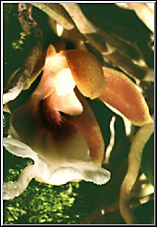 Trichocentrum cornucopiae |
ON:
What we knew until now with this nomenclature, would be, in fact, Galeandra
claesii. Cláudio: Trichocentrum cornucopiae may be is a synomym of Trichocentrum fuscum which occurs in Rio de Janeiro. |
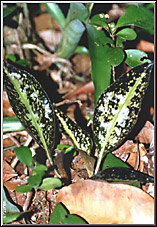 Pelexia
maculata Pelexia
maculata |
ON: And about Pelexia maculata which were just reported tro the states of Pará and Amazonas? Cláudio:
This is also a crazing thing, a plant with golden leaves. |
|
ON: Those Those simultaneous occurrences in Espírito Santo/Bahia with plants from the Amazon region aroused my curiosity. You are saying that this region would be a continuation of the Amazon Hylean. How? Cláudio:
Many people told it. Martius talked about. The name of Baiana Hylean passing
by the Amazon Hylean. The question is interesting because with orchids,
we have the sensation that the migratory event is possible. The seed is
light so it is easy to fly. When you are analyzing and you see that the
orchids is behaving in a way similar to the trees, you say to yourself:"
- Wait a minute. If it comes for migration, why a Lecyitidaceae
doesn't do. ON: You mean, the Amazon forest has already come until the north of Espírito Santo and south of Bahia? Cláudio: Yes. One day, they were together but an arid zone grown separating the two big forests. There are are the peculiarities of soil: clayish sedimentary and very sandy soil, placed in lowlands, flat, similar to Amazon. The bigger diversification occurred in the hillside. ON: But it wouldn't be equal forest. Cláudio: Equal no but they were connected, they... ON: But they would be different. They would be very different. Cláudio:
But the kept for more time the same characteristics while the hillside
Atlantic forest made possible a great appearance of habitats that justifies
the appearance of new species. This is one of the explanations.
Cláudio:
Very crazy, that is why I want to go until the south of Bahia, until Salvador
in order to, in the future, do an analyze of the sandbanks from the Pará
until Rio Grande do Sul. It seems that Salvador forms a barrier of plants.
ON: How many years you think you will live? With all those projects... You should live 200 years, at least. Cláudio: The master degree took six years and the doctorate will take four. ON: Yes but you have also this project of hydrographical basins... Cláudio:
No, this one I wouldn't do but it is an opportunity that my work could
generate. ON: Recently we talked about the occurrence of the orchids in the sandbanks of Rio de Janeiro, mainly in Massambaba, we used the information gathered by Maria da Penha Fagnani and the research done by Dorothy Sue Dunn Araujo. What did you find in common between the sandbanks of Espírito Santo and Rio de Janeiro? Are they more or less uniform, are they similar? |
| Cláudio:
They are but it occurs what I have already said: the substitution of the
species. Species that occur in the Atlantic Forest of Rio de Janeiro, but
don't in the Atlantic forest of Espírito Santo, or may be those species
of Atlantic Forest are coming from the south to the north but the limit
of distribution stops at Rio de Janeiro. Such Cattleya intermedia
and Cattleya forbesii in Rio de Janeiro. |
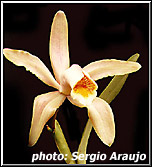 Cattleya forbesii |
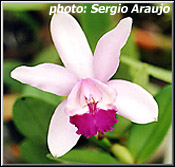 Cattleya intermedia |
| Whcih
plant substitutes Cattleya intermedia in Espírito Santo? Cattleya harrisoniana which comes until Campos, in the state of Rio de Janeiro. The substitution of species occurs and the species are different. They speciated themselves in this way, they occupy the place we use to call ecological niche but they are two different things. Why? Because one own to that habitat and the other to this. Both occur inside the sandbank. |
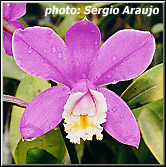 Cattleya harrisoniana |